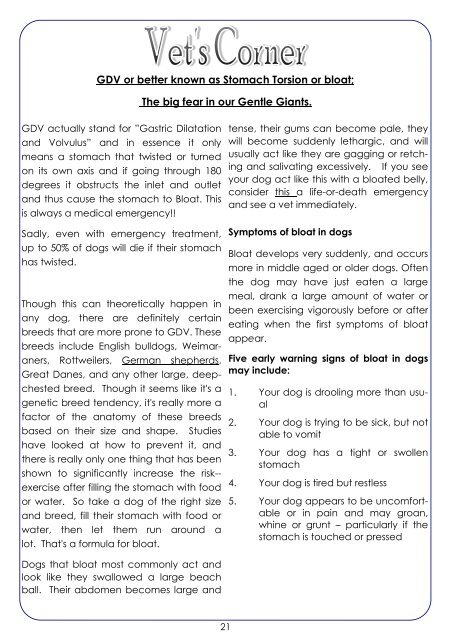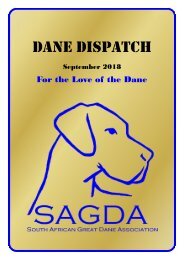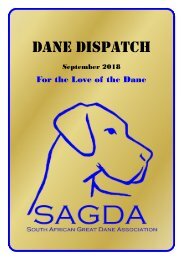Dane DispatchNov2017
Create successful ePaper yourself
Turn your PDF publications into a flip-book with our unique Google optimized e-Paper software.
GDV actually stand for ”Gastric Dilatation<br />
and Volvulus” and in essence it only<br />
means a stomach that twisted or turned<br />
on its own axis and if going through 180<br />
degrees it obstructs the inlet and outlet<br />
and thus cause the stomach to Bloat. This<br />
is always a medical emergency!!<br />
Sadly, even with emergency treatment,<br />
up to 50% of dogs will die if their stomach<br />
has twisted.<br />
Though this can theoretically happen in<br />
any dog, there are definitely certain<br />
breeds that are more prone to GDV. These<br />
breeds include English bulldogs, Weimaraners,<br />
Rottweilers, German shepherds,<br />
Great <strong>Dane</strong>s, and any other large, deepchested<br />
breed. Though it seems like it's a<br />
genetic breed tendency, it's really more a<br />
factor of the anatomy of these breeds<br />
based on their size and shape. Studies<br />
have looked at how to prevent it, and<br />
there is really only one thing that has been<br />
shown to significantly increase the risk--<br />
exercise after filling the stomach with food<br />
or water. So take a dog of the right size<br />
and breed, fill their stomach with food or<br />
water, then let them run around a<br />
lot. That's a formula for bloat.<br />
GDV or better known as Stomach Torsion or bloat;<br />
Dogs that bloat most commonly act and<br />
look like they swallowed a large beach<br />
ball. Their abdomen becomes large and<br />
The big fear in our Gentle Giants.<br />
tense, their gums can become pale, they<br />
will become suddenly lethargic, and will<br />
usually act like they are gagging or retching<br />
and salivating excessively. If you see<br />
your dog act like this with a bloated belly,<br />
consider this a life-or-death emergency<br />
and see a vet immediately.<br />
Symptoms of bloat in dogs<br />
Bloat develops very suddenly, and occurs<br />
more in middle aged or older dogs. Often<br />
the dog may have just eaten a large<br />
meal, drank a large amount of water or<br />
been exercising vigorously before or after<br />
eating when the first symptoms of bloat<br />
appear.<br />
Five early warning signs of bloat in dogs<br />
may include:<br />
1. Your dog is drooling more than usual<br />
2. Your dog is trying to be sick, but not<br />
able to vomit<br />
3. Your dog has a tight or swollen<br />
stomach<br />
4. Your dog is tired but restless<br />
5. Your dog appears to be uncomfortable<br />
or in pain and may groan,<br />
whine or grunt – particularly if the<br />
stomach is touched or pressed<br />
21




